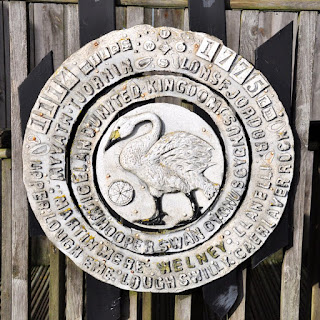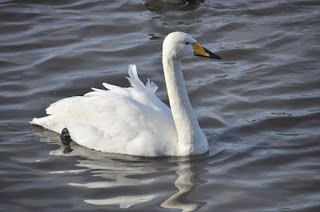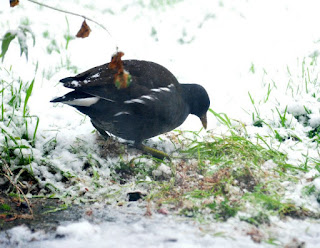I am rather enjoying the current warm spell, though I'm wondering how much longer it will last... I've already seen a butterfly (though it flew by too quickly for me to identify it, maybe a small tortoiseshell), and the birds definitely seem to be in springtime mode, with various individuals flying around with nesting material.
The problem, of course, is that insects that have been dormant in the cold of winter become active, and if they can't find enough food they will struggle. So it's a great idea to have things in your garden that will help them out - mahonia is one. It flowers from January through to about March, and provides an early supply of nectar and pollen when there's not much else about.
It seems to be a tough enough plant - in my garden it lives in front of a row of tall conifers, with all the shading and moisture problems they bring, and still thrives. In the sunshine there were at least half a dozen honey bees visiting, plus a couple of buff-tailed bumblebee queens.
There's lots of information online about pollinator-friendly plants for the garden, including this from Friends of the Earth. With a little planning you can have wildlife-friendly flowers all through the seasons!
Saturday, 23 February 2019
Saturday, 9 February 2019
A visit to Welney WWT
Having checked the weather forecast (which was looking surprisingly good!), I decided to take a day off this week to visit the Wildfowl and Wetlands Trust (WWT) at Welney. The reserve is on the Ouse Washes, washlands which take up floodwater from the River Great Ouse and keep safe vast areas of farmland and settlements. The WWT manages about 3 of the 22 miles of the Washes, and the visitor centre and reserve are well worth exploring.
The Ouse Washes is an SSSI and a Ramsar site, and is a massively important area for wildfowl. The WWT staff gave a short talk about the reserve and the organisation (in the comfort of a very nice heated main hide), and according to this there are currently around 76,000 waterfowl present across the Washes. Amazing.
My main reason for visiting Welney - other than it having been on my list of places to visit for such a long time - was to see Whooper swans. These swans breed in Iceland and overwinter in the UK and Ireland, making the journey across the North Sea in one non-stop flight (nearly 1800 km to the Ouse Washes); counts here are generally up in the thousands. The swans feed in the surrounding fields during the day, and fly back onto the washland to roost and, at Welney, for a top-up of grain provided by the WWT, who also ring and monitor the birds. As well as the Whoopers there are Bewick's swans: smaller and shyer, and fewer in number.
Another must-see bird for me at Welney is the Black-tailed godwit - the species here is the focus of a project to increase their numbers. They were present, but the flocks were too far away for me to get a good view, other than the spectacle of them all in flight, put up by a passing marsh harrier.
I had great views of the Whooper swans on the lagoon in front of the main hide, and an absolute bonus for me was the huge number of Pochards that were there too - I have never seen so many all in one place! Most were males - the females fly further south and overwinter in France and Spain. This is yet another species in decline, and the WWT are undertaking research into this. For my part, I just loved watching, drawing and painting them - they are perfect little blocks of colour.
I could have spent all day drawing the wildfowl here - maybe I should have! Next time...
The Ouse Washes is an SSSI and a Ramsar site, and is a massively important area for wildfowl. The WWT staff gave a short talk about the reserve and the organisation (in the comfort of a very nice heated main hide), and according to this there are currently around 76,000 waterfowl present across the Washes. Amazing.
My main reason for visiting Welney - other than it having been on my list of places to visit for such a long time - was to see Whooper swans. These swans breed in Iceland and overwinter in the UK and Ireland, making the journey across the North Sea in one non-stop flight (nearly 1800 km to the Ouse Washes); counts here are generally up in the thousands. The swans feed in the surrounding fields during the day, and fly back onto the washland to roost and, at Welney, for a top-up of grain provided by the WWT, who also ring and monitor the birds. As well as the Whoopers there are Bewick's swans: smaller and shyer, and fewer in number.
Another must-see bird for me at Welney is the Black-tailed godwit - the species here is the focus of a project to increase their numbers. They were present, but the flocks were too far away for me to get a good view, other than the spectacle of them all in flight, put up by a passing marsh harrier.
I had great views of the Whooper swans on the lagoon in front of the main hide, and an absolute bonus for me was the huge number of Pochards that were there too - I have never seen so many all in one place! Most were males - the females fly further south and overwinter in France and Spain. This is yet another species in decline, and the WWT are undertaking research into this. For my part, I just loved watching, drawing and painting them - they are perfect little blocks of colour.
I could have spent all day drawing the wildfowl here - maybe I should have! Next time...
Saturday, 2 February 2019
Snowy tracks
Well, we had some snow here but not much! Just enough to cover the lawn while still letting the grass to poke through. And it didn't last long - it had mostly melted away by lunchtime. There was enough, however, to show some interesting tracks across the driveway...
So, out came the nature journal, along with my little three-legged fold-up stool in an attempt to keep me out of the snow. I measured the tracks so I could draw them life-sized, although a certain amount of melting was already happening...
The track-leaving culprit is a moorhen. Although we're not near a river or lake, there are ponds in the village (including one next door), as well as ditches and drains, and we have at least two resident moorhens that we see quite regularly.
Drawing this reminded me of some sketches I made a few years ago, when I looked out of an upstairs window and found a moorhen at eye level, perched up in the conifers!
So, out came the nature journal, along with my little three-legged fold-up stool in an attempt to keep me out of the snow. I measured the tracks so I could draw them life-sized, although a certain amount of melting was already happening...
The track-leaving culprit is a moorhen. Although we're not near a river or lake, there are ponds in the village (including one next door), as well as ditches and drains, and we have at least two resident moorhens that we see quite regularly.
Drawing this reminded me of some sketches I made a few years ago, when I looked out of an upstairs window and found a moorhen at eye level, perched up in the conifers!
Subscribe to:
Posts (Atom)


















